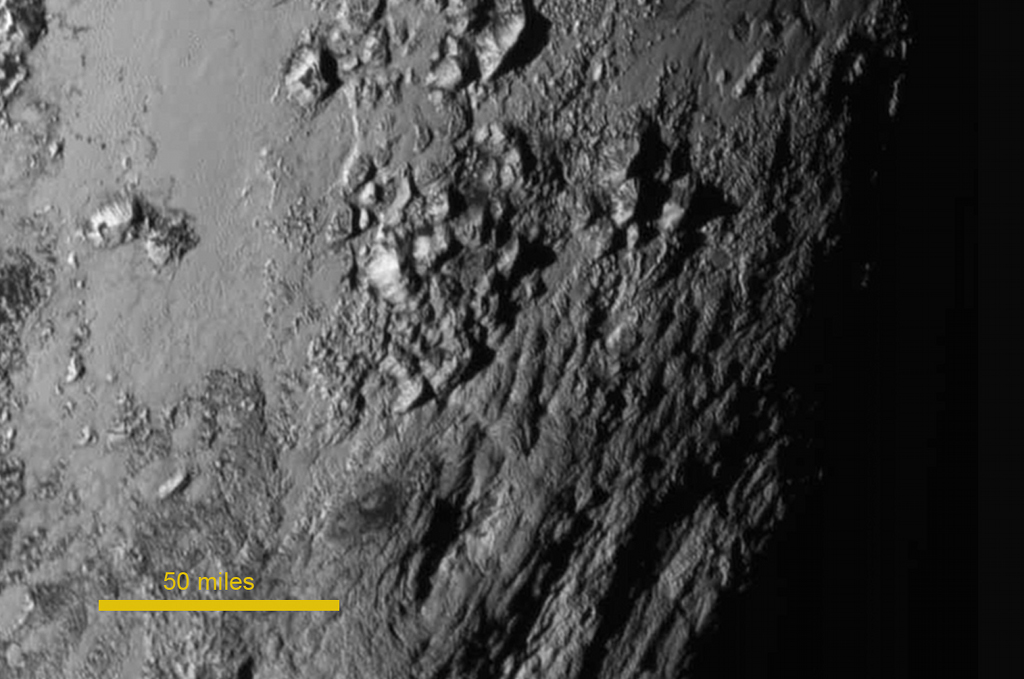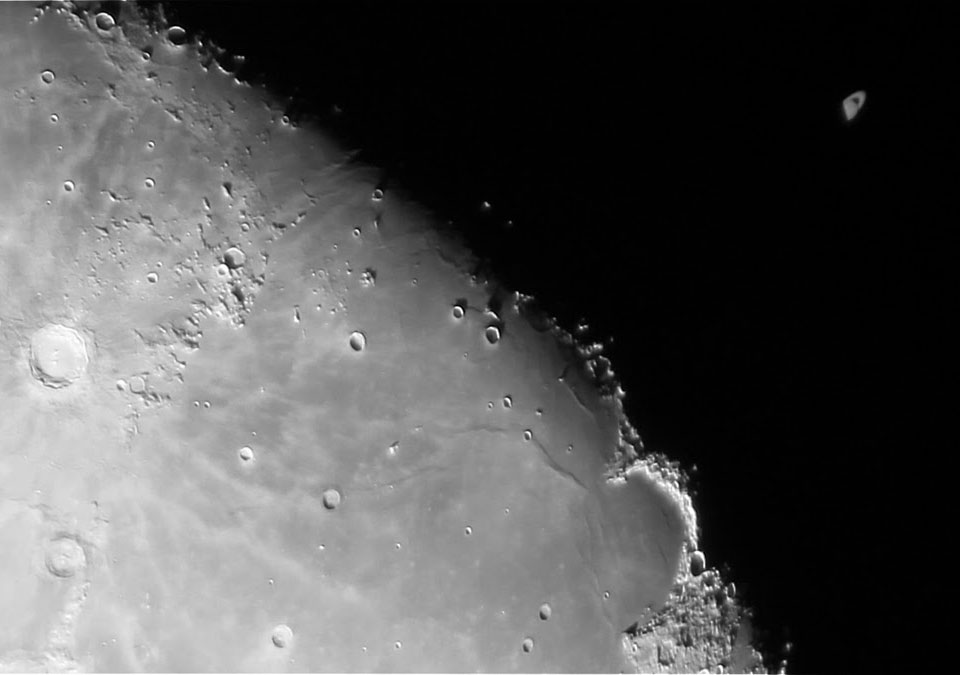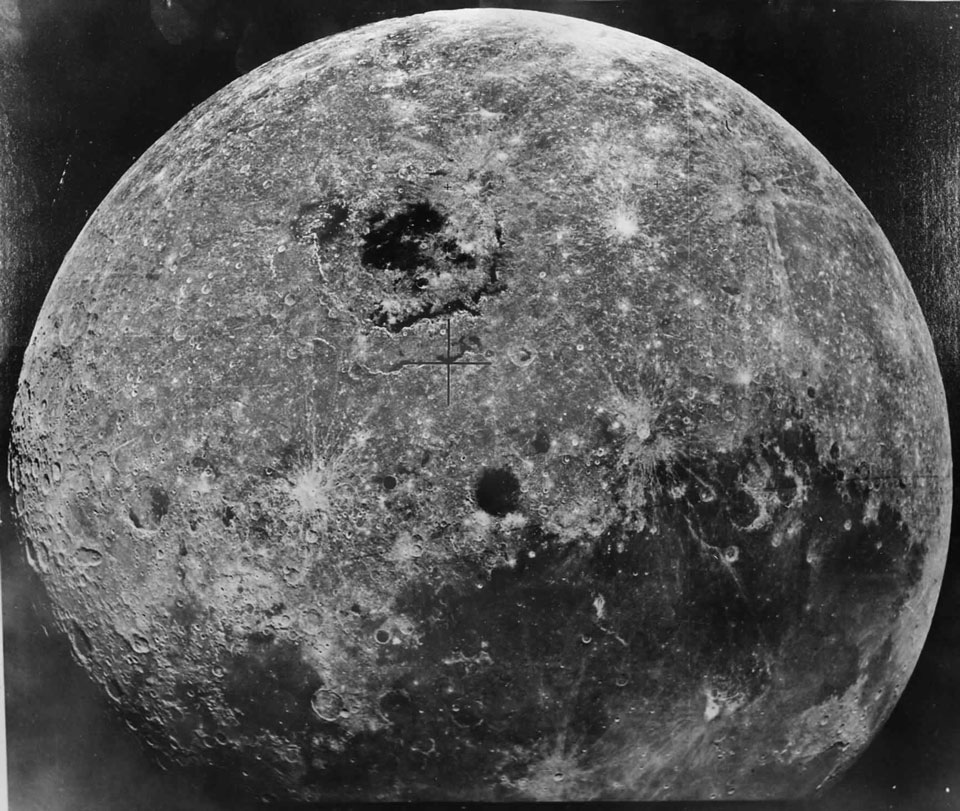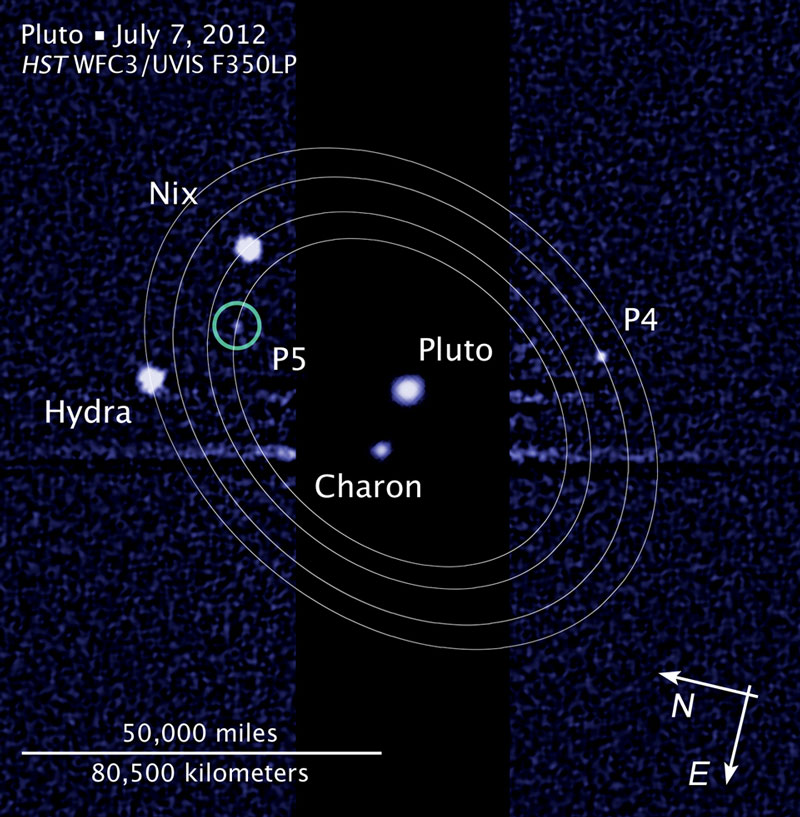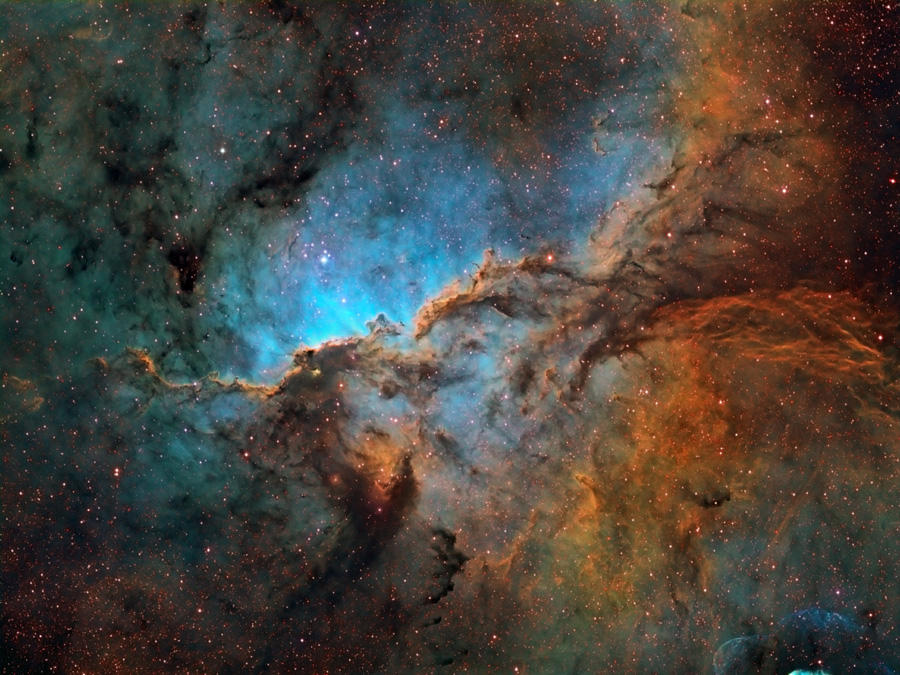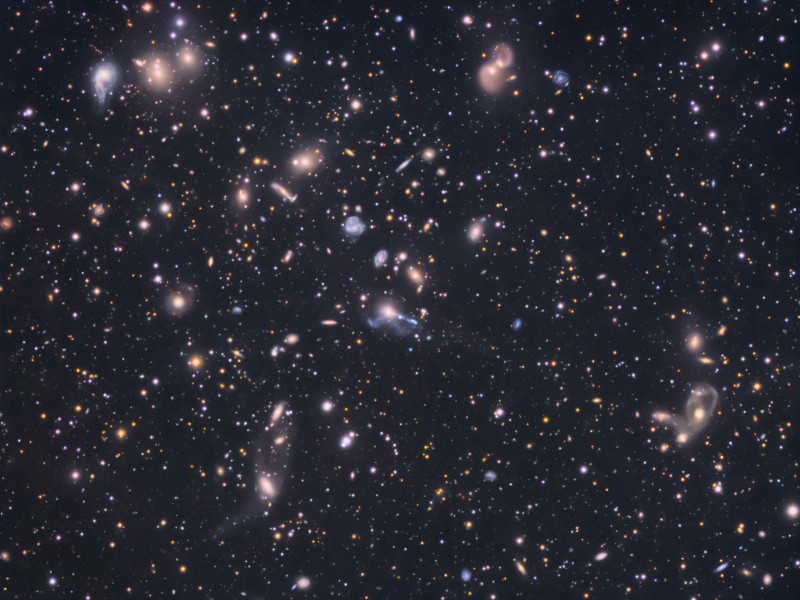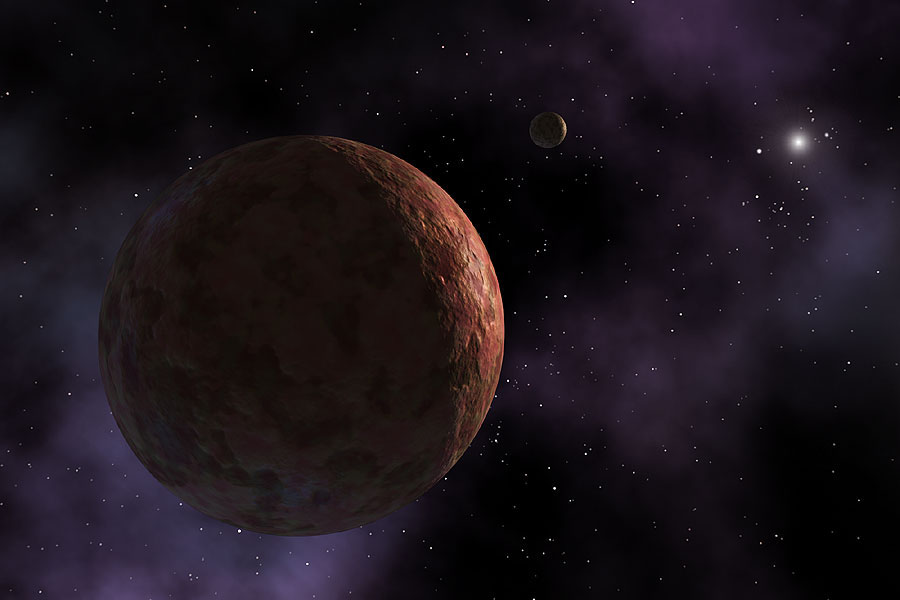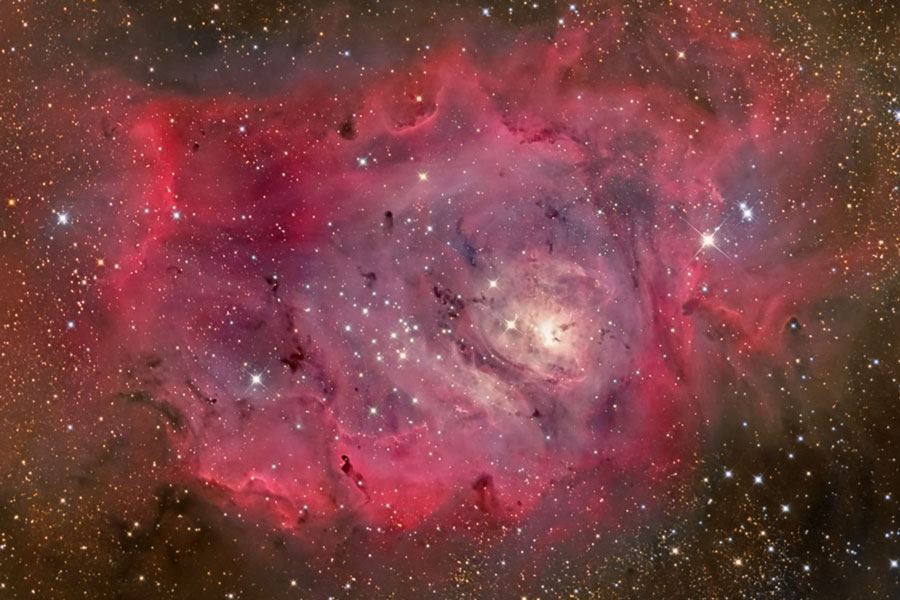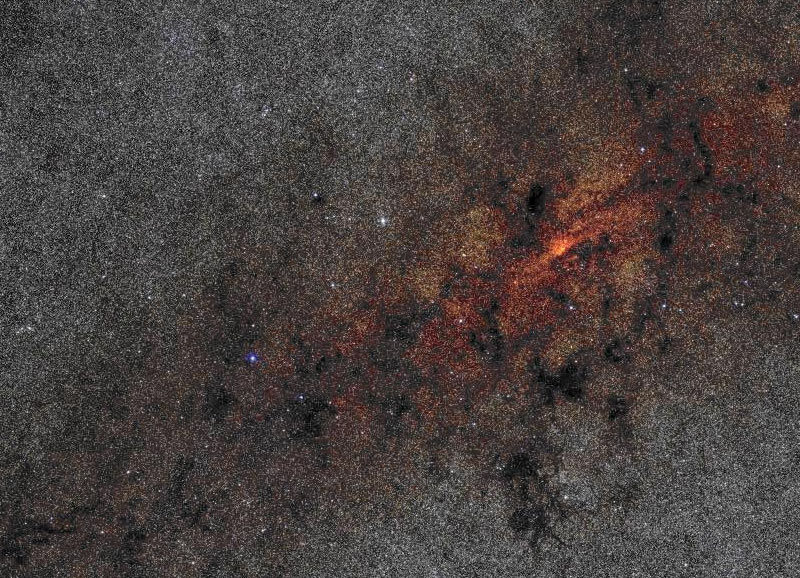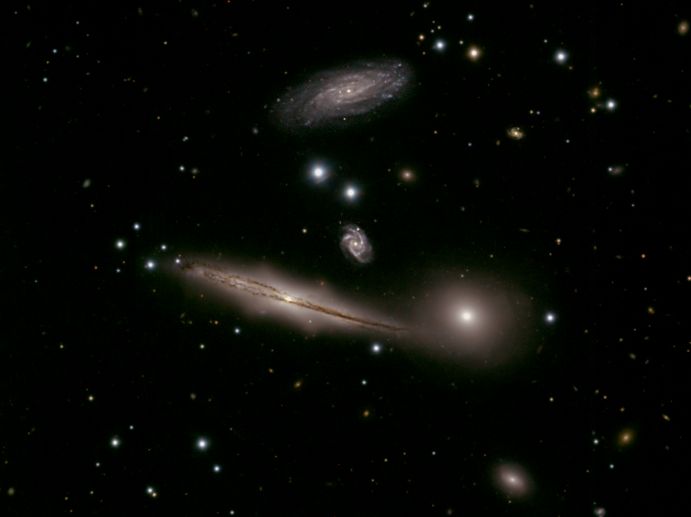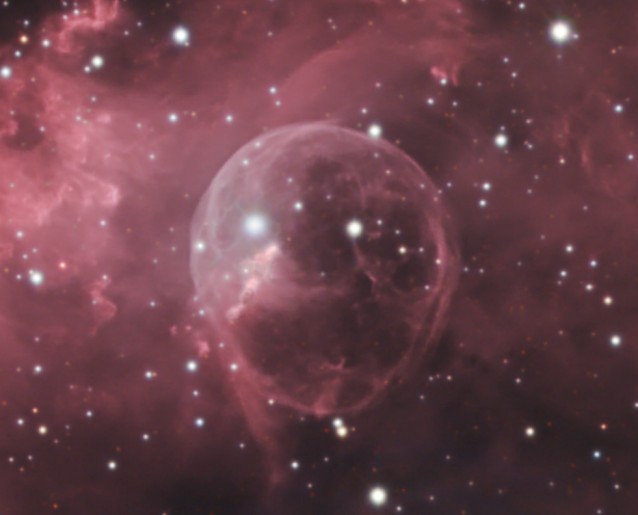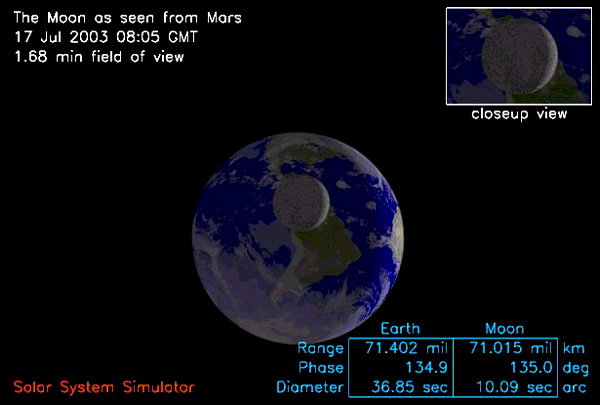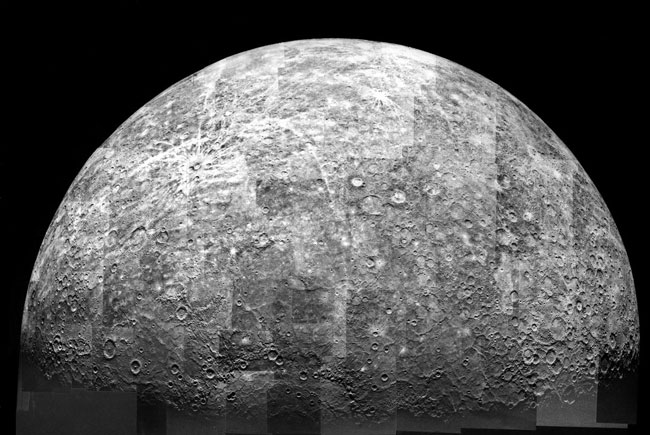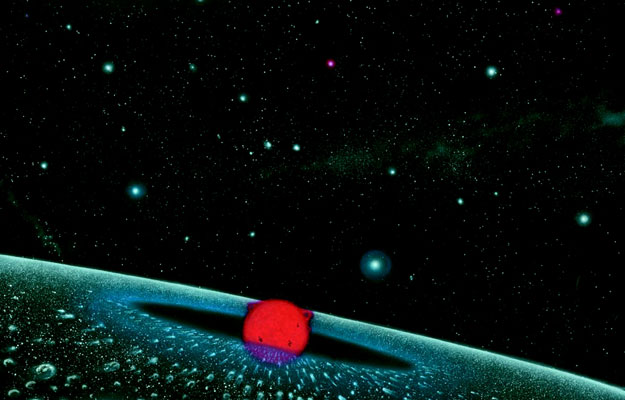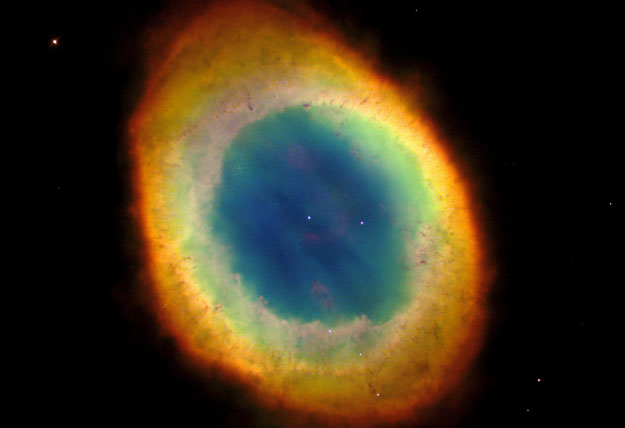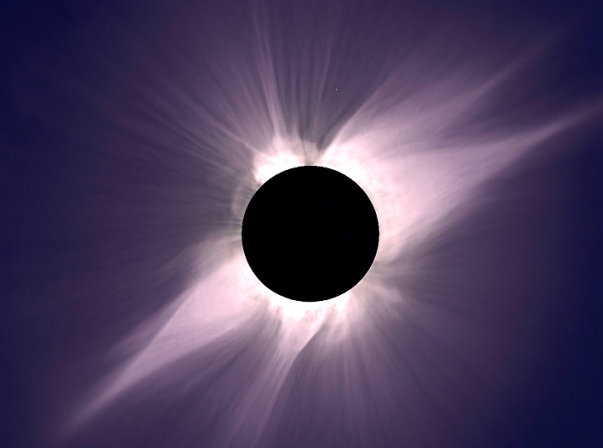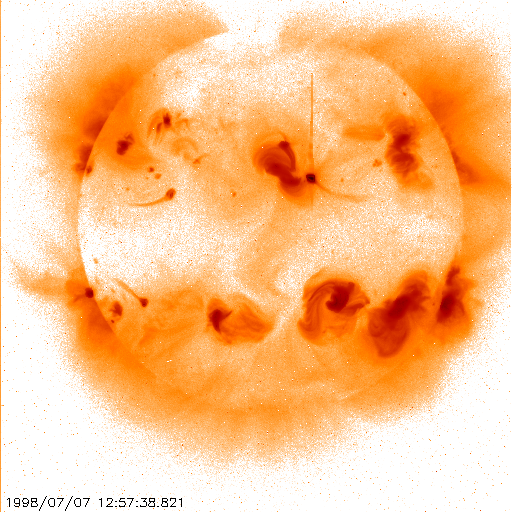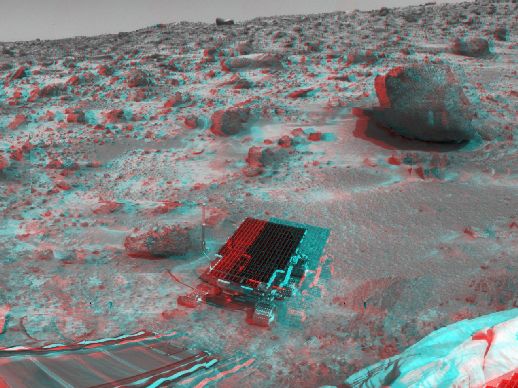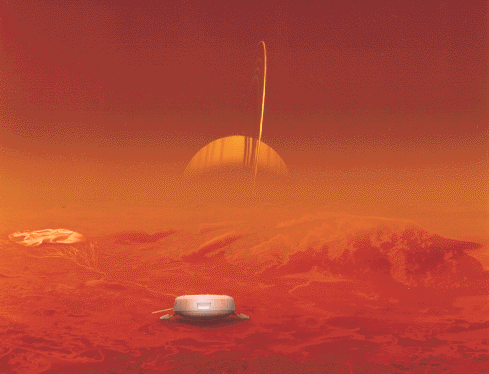| << Previous | Index | Next >> |
2015 A 50 mile (80 kilometer) trip across Pluto would cover the distance indicated by the scale bar in this startling image. The close-up of the icy world's rugged equatorial terrain was captured when the New Horizons spacecraft was about 47,800 miles (77,000 kilometers) from the surface, 1.5 hours before its closest approach. Rising to an estimated 11,000 feet (3,500 meters) the mountains are likely composed of water ice. Suggesting surprising geological activity, they are also likely young with an estimated age of 100 million years or so based on the apparent absence of craters. The region pictured is near the base of Pluto's broad, bright, heart-shaped feature.
2014 What happened to half of Saturn? Nothing other than Earth's Moon getting in the way. As pictured above on the far right, Saturn is partly eclipsed by a dark edge of a Moon itself only partly illuminated by the Sun. This year the orbits of the Moon and Saturn have led to an unusually high number of alignments of the ringed giant behind Earth's largest satellite. Technically termed an occultation, the above image captured one such photogenic juxtaposition from Buenos Aires, Argentina that occurred early last week. Visible to the unaided eye but best viewed with binoculars, there are still four more eclipses of Saturn by our Moon left in 2014. The next one will be on August 4 and visible from Australia, while the one after will occur on August 31 and be visible from western Africa at night but simultaneously from much of eastern North America during the day.
2013 Which moon is this? Earth's. Our Moon's unfamiliar appearance is due partly to an unfamiliar viewing angle as captured by a little-known spacecraft -- the Soviet Union's Zond 8 that circled the Moon in October of 1970. Pictured above, the dark-centered circular feature that stands out near the top of the image is Mare Orientale, a massive impact basin formed by an ancient collision with an asteroid. Mare Orientale is surrounded by light colored and highly textured highlands. Across the image bottom lies the dark and expansive Oceanus Procellarum, the largest of the dark (but dry) maria that dominate the side of the Moon that always faces toward the Earth. Originally designed to carry humans, robotic Zond 8 came within 1000 km of the lunar surface, took about 100 detailed photographs on film, and returned them safely to Earth within a week.
2012 A fifth moon has been discovered orbiting Pluto. The moon was discovered earlier this month in images taken by the Hubble Space Telescope in preparation for the New Horizons mission's scheduled flyby of Pluto in 2015. Pictured above, the moon is currently seen as only a small blip that moves around the dwarf planet as the entire system slowly orbits the Sun. The moon, given a temporary designation of S/2012 (134340) 1 or just P5 (as labeled), is estimated to span about 15 kilometers and is likely composed mostly of water-ice. Pluto remains the only famous Solar System body never visited by a human-built probe and so its origins and detailed appearance remain mostly unknown.
2011
[imghover6=http://apod.nasa.gov/apod/image/1107/To ... hi600h.jpg]http://apod.nasa.gov/apod/image/1107/To ... -Label.jpg[/imghover6]Image Credit & Copyright: Babak Tafreshi (TWAN)
2010 Dark shapes with bright edges winging their way through dusty NGC 6188 are tens of light-years long. The emission nebula is found near the edge of an otherwise dark large molecular cloud in the southern constellation Ara, about 4,000 light-years away. Formed in that region only a few million years ago, the massive young stars of the embedded Ara OB1 association sculpt the fantastic shapes and power the nebular glow with stellar winds and intense ultraviolet radiation. The recent star formation itself was likely triggered by winds and supernova explosions, from previous generations of massive stars, that swept up and compressed the molecular gas. A false-color Hubble palette was used to create this sharp close-up image and shows emission from sulfur, hydrogen, and oxygen atoms in red, green, and blue hues. At the estimated distance of NGC 6188, the picture spans about 200 light-years.
2009 These are galaxies of the Hercules Cluster, an archipelago of island universes a mere 500 million light-years away. Also known as Abell 2151, this cluster is loaded with gas and dust rich, star-forming spiral galaxies but has relatively few elliptical galaxies, which lack gas and dust and the associated newborn stars. The colors in this remarkably deep composite image clearly show the star forming galaxies with a blue tint and galaxies with older stellar populations with a yellowish cast. The sharp picture spans about 3/4 degree across the cluster center, corresponding to over 6 million light-years at the cluster's estimated distance. In the cosmic vista many galaxies seem to be colliding or merging while others seem distorted - clear evidence that cluster galaxies commonly interact. In fact, the Hercules Cluster itself may be seen as the result of ongoing mergers of smaller galaxy clusters and is thought to be similar to young galaxy clusters in the much more distant, early Universe.
2008 Recently discovered Makemake is one of the largest objects known in the outer Solar System. Pronounced MAH-kay MAH-kay, this Kuiper belt object is only slightly smaller than Pluto, orbits the Sun only slightly further out than Pluto, and appears only slightly dimmer than Pluto. Makemake, however, has an orbit much more tilted to the ecliptic plane of the planets than Pluto. Designated 2005 FY9 soon after its discovery by a team led by Mike Brown (Caltech) in 2005, the outer Solar System orb was recently renamed Makemake for the creator of humanity in the Rapa Nui mythology of Easter Island. Additionally, Makemake has been recently classified as a dwarf planet under the new subcategory plutoid, making Makemake the third cataloged plutoid after Pluto and Eris. Makemake is known to be a world somewhat red in appearance, with spectra indicating it is likely covered with frozen methane. Since no images of Makemake's surface yet exist, an artist's illustration originally meant to depict Sedna has been boldly co-opted above to now illustrate Makemake. A hypothetical moon is visualized above nearly in the direction of our distant Sun.
2007 Stars are battling gas and dust in the Lagoon Nebula but the photographers are winning. Also known as M8, this photogenic nebula is visible even without binoculars towards the constellation of Sagittarius. The energetic processes of star formation create not only the colors but the chaos. The red-glowing gas results from high-energy starlight striking interstellar hydrogen gas. The dark dust filaments that lace M8 were created in the atmospheres of cool giant stars and in the debris from supernovae explosions. The light from M8 we see today left about 5,000 years ago. Light takes about 50 years to cross this section of M8.
2006 The center of our Galaxy is a busy place. In visible light, much of the Galactic Center is obscured by opaque dust. In infrared light, however, dust glows more and obscures less, allowing nearly one million stars to be recorded in the above photograph. The Galactic Center itself appears on the right and is located about 30,000 light years away towards the constellation of Sagittarius. The Galactic Plane of our Milky Way Galaxy, the plane in which the Sun orbits, is identifiable by the dark diagonal dust lane. The absorbing dust grains are created in the atmospheres of cool red-giant stars and grow in molecular clouds. The region directly surrounding the Galactic Center glows brightly in radio and high-energy radiation, and is thought to house a large black hole.
2005 Posing for this cosmic family photo are the galaxies of HCG (Hickson Compact Group) 87, about four hundred million light-years distant toward the amphibious constellation Capricornus. The large edge-on spiral near picture center, the fuzzy elliptical galaxy immediately to its right, and the spiral near the top of the image are identified members of the group, while the small spiral galaxy in the middle is likely a more distant background galaxy. In any event, a careful examination of the deep image reveals other galaxies which certainly lie far beyond HCG 87. While not exactly locked in a group hug, the HCG 87 galaxies are interacting gravitationally, influencing their fellow group members' structure and evolution. This image is from the commissioning phase of an instrument on the Gemini Observatory's South Telescope at Cerro Pachon, Chile. It compares favorably with views of this photogenic galaxy group recorded by the Hubble Space Telescope.
2004 Blown by the wind from a star, this tantalizing, ghostly apparition is cataloged as NGC 7635, but known simply as The Bubble Nebula. Astronomer Ken Crawford's striking view combines a long exposure through a hydrogen alpha filter with color images to reveal the intricate details of this cosmic bubble and its environment. Although it looks delicate, the 10 light-year diameter bubble offers evidence of violent processes at work. Seen here above and left of the Bubble's center is a bright hot star embedded in telltale blue hues characteristic of dust reflected starlight. A fierce stellar wind and intense radiation from the star, which likely has a mass 10 to 20 times that of the Sun, has blasted out the structure of glowing gas against denser material in a surrounding molecular cloud. The intriguing Bubble Nebula lies a mere 11,000 light-years away toward the boastful constellation Cassiopeia.
2003 When earthdweller Patrick Vantuyne wondered what his home planet's single large moon would look like if viewed from Mars on July 17, he availed himself of the JPL Solar System Simulator. Of course, when viewed from Earth on that date (tomorrow), the gibbous Moon will pass tantalizingly close to Mars for observers in North, Central, and South America and will actually pass in front of (occult) the Red Planet for some locations, including much of Florida. Vantuyne's efforts were rewarded with this remarkable simulated view of the crescent Moon against the background of a darkened Earth. From the martian vantage point, the lunar orb is seen just below the tip of the Florida peninsula at 8:05 GMT. Observers on planet Earth who want to watch the corresponding Moon/Mars show in tomorrow's predawn sky should note the viewing times for selected cities.
2002 After just passing Mercury, the robot spacecraft Mariner 10 looked back. The above picture is what it saw. Mercury, the closest planet to the Sun, is heavily cratered much like Earth's Moon. As Mercury slowly rotates, its surface temperature varies from an unbearably cold -180 degrees Celsius in the half facing away from the Sun, to an unbearably hot 400 degrees Celsius in the half facing toward the Sun. Mercury is slightly larger than Earth's Moon and much denser. The Mariner 10 spacecraft swooped by Mercury three times in its journey around the inner Solar System in the mid-1970s. This outbound view has similarities to the inbound view. Nearly half of Mercury's surface has yet to be photographed in detail.
2001 Do worlds outside our Solar System have oceans of water like Earth? An indication that such worlds might exist was bolstered recently by new evidence that nearby star system CW Leonis harbors water. Recent observations with the Submillimeter Wave Astronomy Satellite (SWAS) found significant detections of light at specific colors emitted by water. A hypothesis quickly arose that the activity of the central star is vaporizing water from a cloud of comets that surrounds the star -- a cloud that may be similar to the Kuiper Belt of comets that surrounds our own Sun. The above drawing depicts the CW Leonis system with its hypothesized cloud of water-bearing comets situated to a ring. The closest comets are depicted as showing tails rich in water vapor pointing away from the star. Far from the central star, however, comets should not show significant tails and should be more sparsely spaced. The central star, also known as IRC+10216, is an aging giant star located about 500 light-years away toward the constellation of Leo.
2000 Except for the rings of Saturn, The Ring Nebula (M57) is probably the most famous celestial band. This planetary nebula's simple, graceful appearance is thought to be due to perspective -- our view from planet Earth looking straight into what is actually a barrel-shaped cloud of gas shrugged off by a dying central star. Astronomers of the Hubble Heritage Project produced this strikingly sharp image from Hubble Space Telescope observations using natural appearing colors to indicate the temperature of the stellar gas shroud. Hot blue gas near the energizing central star gives way to progressively cooler green and yellow gas at greater distances with the coolest red gas along the outer boundary. Dark, elongated structures can also be seen near the nebula's edge. The Ring Nebula is about one light-year across and 2,000 light-years away in the northern constellation Lyra.
1999
1998 Recorded on July 7, this animation using X-ray images of the Sun shows an amazing event - three nearly simultaneous jets connected with solar active regions. The two frames were taken several hours apart by the Soft X-ray Telescope on board the orbiting Yohkoh observatory. They have a "negative" color scheme, the darker colors representing more intense X-rays from the corona and active regions on the solar surface. The pictures clearly show two curving jets of X-ray hot plasma appearing above the solar equator and one below. A sharp vertical stripe near the jet above center is a digital blemish while the overall shift of the image is due to solar rotation. As the Sun is now approaching the active part of its 11 year cycle, similar single jets are seen every week or so. But the appearance of these three widely separated jets at once is considered an unlikely coincidence and is fueling current speculations about their origins.
1997 A ramp from the Pathfinder lander, the Sojourner robot rover, airbags, a couch, Barnacle Bill, and Yogi Rock appear together in this 3D stereo view of the surface of Mars. Barnacle Bill is the rock just left of the solar-paneled Sojourner and Yogi is the big friendly-looking boulder at the right. The "couch" is the angular rock shape visible on the horizon. Look at the image with red/blue glasses (... or just hold a piece of clear red plastic over your left eye and blue or green over your right) to get the dramatic 3D perspective. The stereo view was recorded by the remarkable Imager for Mars Pathfinder (IMP) camera. The IMP has two optical paths for stereo imaging and ranging and is equipped with an array of color filters for spectral analysis. Operating as the "first astronomical observatory on Mars" the IMP has also recorded images of the Sun and Deimos, the smallest of Mars' two tiny moons. Overcoming communications problems and computer resets the Pathfinder is transmitting new color images which should be available July 18.
1996 The above artistic portrait of Saturn depicts how it might look from Titan, Saturn's largest moon. In the foreground sits ESA's Huygens probe, which will be released by NASA's Cassini spacecraft. The Cassini mission to Saturn in currently planned for launch in late 1997. Cassini will reach Saturn in 2004 and will release the Huygens probe later that year. Titan is one of only two moons in the Solar System to have an atmosphere, It has been suggested Titan might have gasoline-like lakes, and may even harbor life.
1995 Thirty years ago NASA's exploration of Mars began. In July of 1965 the Mariner 4 spacecraft flew within 6,000 miles of Mars and returned 21 pictures of the mysterious red planet. NASA's continued exploration of Mars has produced detailed views of the red tinged Martian surface like the one shown above which is a composite of 102 images from the Viking missions to Mars . The composite was constructed by the US Geological Survey.
| << Previous | Index | Next >> |
